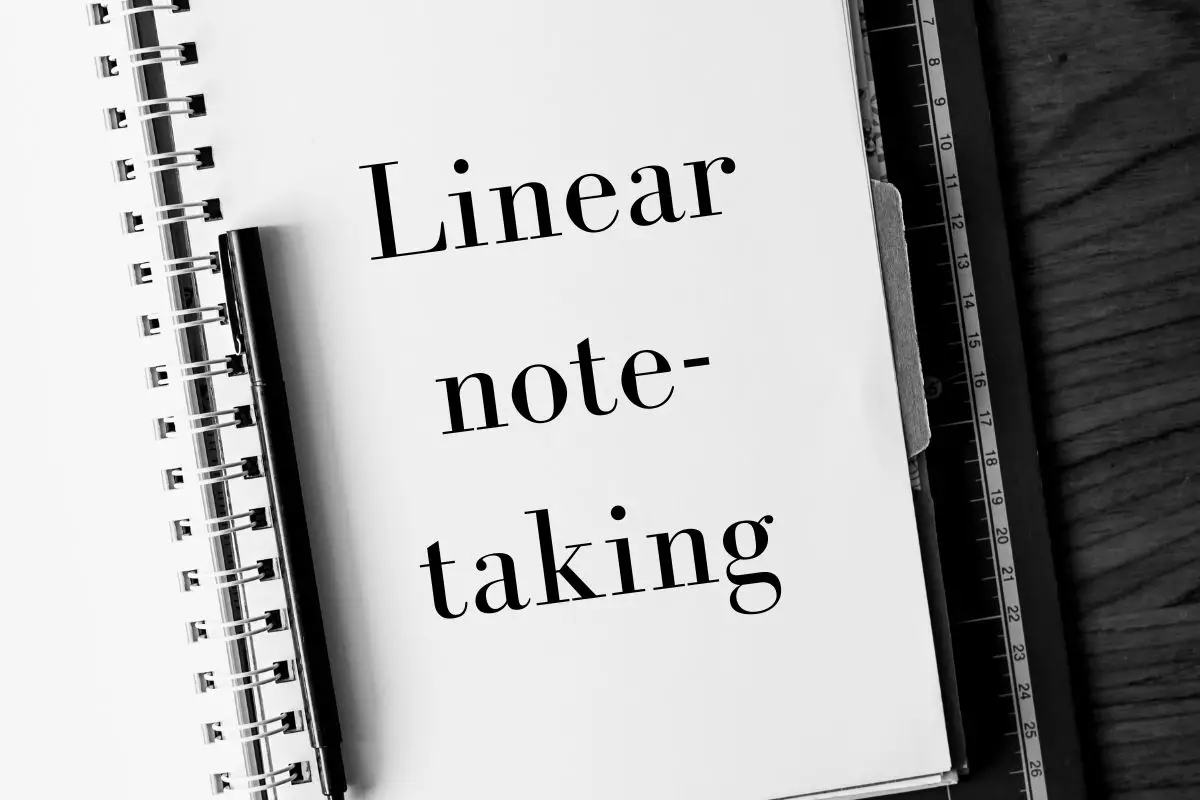There are so many different note-taking terms and methods that it can be difficult to keep them all straight. Almost everyone has seen or even taken linear notes, yet when they hear the term “linear note-taking,” they are still unsure what it is.
I get it; this is how I always took notes, yet I had no idea this was what it was called.
Linear note-taking is when information is recorded and organized in the linear or chronological order that the note-taker hears or reads it. The format includes headings and subheadings for main points and bullet points or numbers to record the details and examples.
It is the most common note-taking method and may also be called sequential note-taking or outlining.
Let’s learn more about what linear notes are and if they are effective, their main features, advantages and disadvantages, and examples.
Click hereto check out the most popular products for college students.
What are linear notes?
Linear notes are notes written in chronological order of a lecture or a reading. They are organized by topic using headings and subheadings and are not grouped by theme. Linear notes are most commonly outlines, but they also can be taken on handouts or using the Cornell method.
Check out all the benefits of Prime Student. Click here
to sign up for Prime Student.
What are the main features of linear note-taking?
The main features of linear note-taking are:
- they are in chronological order (you move down the list)
- there is a title
- headings are used to concisely record the main ideas
- there are subheadings for the supporting points
- bullet points or numbers are used to organize definitions, explanations, and examples
- they use abbreviations, symbols, and acronyms
Linear notes are usually not in full sentences. They often use indentation and roman numerals, letters, numbers, and bullet points to organize the information.
They are a summarized account of the lecture or text.
Some note-takers may include a key to explain their abbreviations or symbols, especially if they are just starting to use them.
Linear note-taking examples
Linear note-taking can be done using the outline method, the sentence method, or the Cornell Method.
Outline Method
The outline method is the most common linear note-taking example.
- You write a title about the topic and make headings about the main ideas (often using roman numerals).
- Below that, you indent and make subheadings (often using letters)
- Beneath that, you can further indent and use bullet points or numbers to write about details and examples.
Sentence Method
In the sentence method, you write down the main points in individual sentences. They are in chronological order, and you start a new sentence for each new point.
They can be organized using bullet points or numbers.
This is probably the easiest note-taking method.
Cornell Method
The Cornell Method can be done using linear or pattern style note-taking.
The Cornell Method has 3 sections:
- On the left, a smaller cues section for keywords, important information, headings, and key details. Include vocab and any questions that you have.
- On the right, a larger notes column for notes you take during class or while reading.
- A summary section is at the bottom of the page.
Why is linear note-taking important?
Linear note-taking is an important method to record and organize information in a logical order. It can be used to track the progression of a lecture, discussion, or text and makes it easier to review the information. The note-taker is required to focus and identify the main points.
Learn more about the 12 Benefits of Note-Taking .
.
Linear note-taking advantages and disadvantages
Let’s look at the advantages and disadvantages of linear note-taking in more depth.
Advantages of linear note-taking
The advantages of linear note-taking are:
- it requires the note-taker to stay focused and practice active listening
- it teaches the note-taker to identify the main points for headings and subheadings
- it is logical and well organized
- it tracks the progression of a lecture, discussion, or text
- it is an easy note-taking method to do and allows you to take longer notes
- more details, definitions, or examples can be added as bullet points
- it is neat and easy to follow and review
Linear note-taking disadvantages
Linear note-taking disadvantages are:
- you can end up with a lot of notes
- it can be more time consuming
- notes may be harder to revise since they are written chronologically
- it doesn’t show connections as well as note-taking methods that group information by topic or theme
- it can be less memorable
- less visual, which may be worse for people with different learning styles or to convey some types of information
Is linear note-taking effective?
Linear note-taking can be an effective way to record and organize your notes. It is clearly structured and follows the progression of the lecture or text. It identifies main points and is the easiest note-taking method to learn and do.
Note-taking of all kinds helps note-takers to listen actively and focus and provides them a source to easily review and study the information.
However, you can end up with too many notes if you transcribe instead of processing the information and recording only the main ideas and supporting details. Linear note-taking can also be harder for visual learners.
Ultimately, it is best if students try multiple note-taking methods and then decide which method works best for them.
Linear note-taking strategies
To get the most out of linear note-taking, students should:
- keep them organized by using headings, subheadings, indentations, and bullet points or numbers
- use colored pens
 or highlighters
or highlighters on your notes to show different points
on your notes to show different points - focus on functionality instead of spending too much time trying to make your notes neat or pretty
- focus on putting only one main point per heading
- add plenty of supporting details and examples that are in your own words
- use bullet points or numbers to organize the supporting details underneath
- don’t write in full sentences—use abbreviations and symbols
- tailor your note-taking style to your personal preference
- regularly review your notes
Common linear note-taking mistakes to avoid
Finally, let’s look at common linear note-taking mistakes and how to avoid them.
Transcribing
The biggest linear note-taking mistake is transcribing a lecture instead of processing the information and only recording the key points.
Force yourself to think about the topic as you are learning about it and taking notes. Write your notes in your own words and include your own examples.
Not making connections
Another problem is that you may simply record the information and not make any connections.
Look for how ideas are related and include these links in your notes.
Being unable to add to your notes
One downside of taking notes chronologically is that you may have trouble revising and adding to your notes later.
There are several things you can try to prevent this:
- Leave plenty of space beneath your headings to add more information later.
- Start a new page for each main idea so that you have a page dedicated to it but plenty of space to add on later.
- If taking notes by hand, you can write down a specific number for each key point. Then you can rewrite that number each time that topic is brought back up so that you can add to your notes without worrying about running out of space.
Now that you know about linear note-taking, check out more tips for How to Take Better Notes in College .
.


